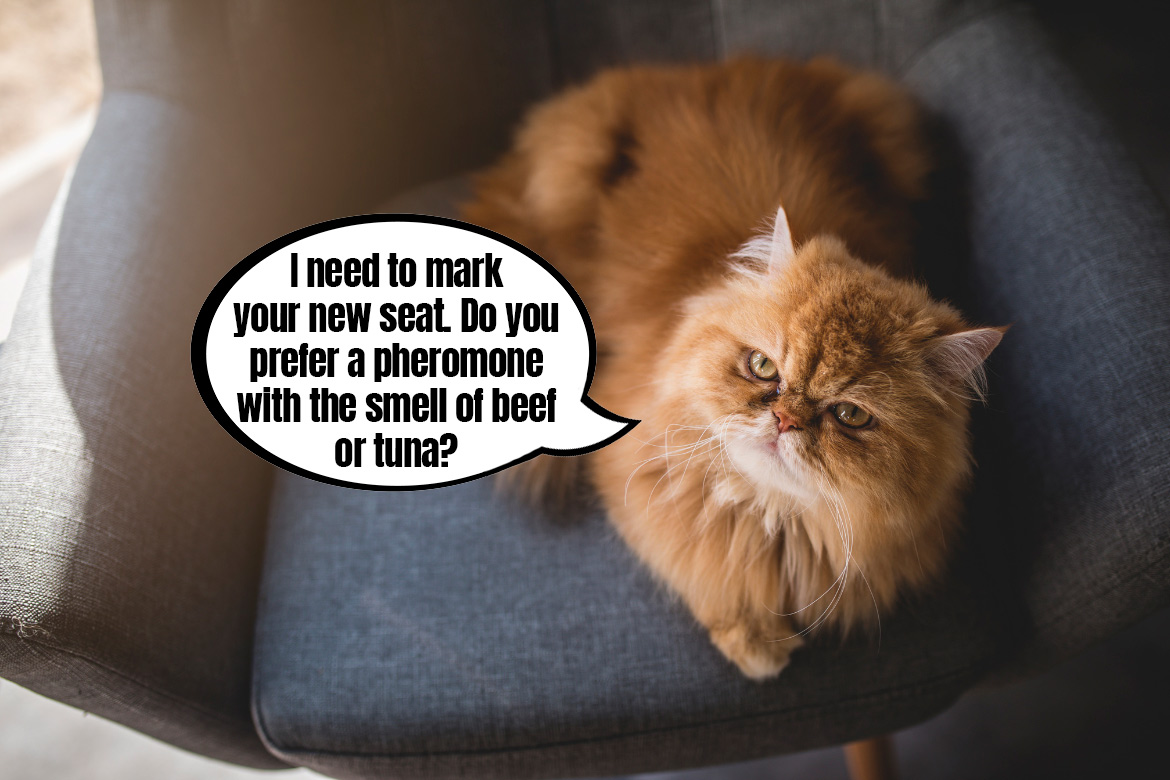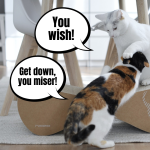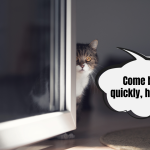Today is World Animal Day – the best time to celebrate the true nature of cats along with our feline friends. Even the couch potatoes and lap cats share the wild energy that their cat ancestors had. And as cat Carers we want to do anything to make our fluffy companions 100% happy, but how can we cater to their wild needs? Today, dear fabCats, we take you on a journey through 5 key needs our domestic cats have and how we can cater to them. Do you know them all?
The need to hunt (and keep up with the hunting cycle)
Cats know more about hunting than many other predators. Though our comfort-loving lap cats can always count on a full bowl in the kitchen, a safe place to stay and the unfailing company of their Carers, their inner predatory energy is still going strong and is not that much different from what their wild cousins, tigers, are like. We can observe our cats’ hunting instincts on a daily basis – whenever an opportunity comes around, they catch the flies that get into the house and will never pass on a chance to observe a spider weaving its web under the ceiling for hours on end. Cats hunt to get food, but also to have fun. In our environment, cats are an invasive species that negatively impacts local ecosystems and populations of many small animals that cats will hunt. Our role, as cat Carers, is to cater to the hunting nature of our cats at home and in such a way that they are happy and fulfilled as a hunter, but without causing damage to the environment. How? Through playtime, of course – one that turns on all of our cats’ instincts and keeps them engaged.
The key to an engaging playtime is following the “hunting cycle”. The first phase is observation – cats can spend several hours watching their target, focused and lurking, sometimes looking like they’re not at all interested, but always aware of what’s going on. The observation stage can be shortened during a playtime, but the idea is to get the cat interested. The toy shouldn’t just appear out of nowhere and within paws’ reach – it has to get the cat’s attention from afar, make them think about a strategy and act on their primal instincts. What’s next? The chase. Some cats like running around, others will extend the observation stage to the maximum and catch the prey quickly and effectively. What we have to remember is that cats are made for speed, not distance – they prefer to hunt quickly and with an element of surprise, but they can do that several times during one playtime. And once the “prey” in the form of a toy is finally caught, it’s time to celebrate and have fun. Your cat can kick the toy, bite it, lick it, groom it – a wild tiger would do the same. And now it’s finally time to consume the prize and finish the hunt and here is we come back into the picture – to close off the hunting cycle, cats need to get their prize in the form of a full bowl of food or some snacks. This is what actually makes them feel like the chase and hunt is over and it’s time to continue with the daily rituals – grooming and sleeping.
How to fight feline boredom? Read more in our article dedicated to playing with your cat: https://blog.mykotty.pl/en/2022/09/05/how-to-combat-feline-boredom/
The need to observe
Observation is a part of hunting, but also a natural part of a cat’s daily routine. Even if we think that our cat is sleeping the entire day, in reality they are almost always staying aware of their surroundings, monitoring what everyone else is doing and making sure that their territory is safe from uninvited intruders. Such a passive form of observation is still consuming quite a lot of a cat’s energy and even if it can never substitute an active, engaging playtime, it shouldn’t be skipped when you’re designing your cat’s environment. Why?
Let’s imagine a scenario in which we’re leaving home for 8-10 hours, leaving the cat all alone. We play with them before we leave and right after we are back, but it still leaves quite a few hours for the cat to kill on their own. Our cat can spend it sleeping (and will surely do so), but they can also observe the world through the window, follow the birds and flies with their eyes, they can even hunt on some insects that dare to get inside the house. Your cat can walk around the entire house and check every nook and cranny to make sure everything’s still in its place. They can nap in the bedroom, walk back to the living room, stretch on their favorite scratcher, rub against the sofa, jump up on the highest shelf to admire their surroundings or even find a hidden snack that the hooman has left around. The life of such a cat is good because even if their Carer is not home, Sir Cat is not bored.
And now for scenario no. 2. We are leaving the house again, but this time we forget to play with the cat beforehand and don’t have much time to do so when we get back either. The one single scratcher is set up in the far corner of the bedroom and all the cat has around is the couch, the office chair, maybe a window sill if they are lucky. What does this cat do with their energy during the day? Without having anything to observe and utilize the energy, when nothing’s there to see out of the window and patrolling the house is limited to walking around on the floor, the cat’s frustration levels will be rising. More and more annoyed, the cat can take it out on our furniture or even us, looking for a way to work on their emotions.
The need for sleep and regeneration
Cats spend a good chunk of their day repeating the same cycle – play, eat, groom, sleep. Both kittens and adult cats can spend 12-16 hours sleeping which sums up to ⅓ of their lives. Not all naps will be a deep, full sleep though – cats often nap while staying very conscious, drawing on their natural instinct to always stay alert. However, if we provide them with safe and secure hideouts, quiet nooks and cozy cat beds (both on the floor and higher up), we give our cats a chance to fully relax – if they feel safe in our presence, they will sleep better.
How to better organize a cat’s chillout space? Besides the couch, your bed or a chair that your cat will happily adapt to be their own, it’s good to make sure that your feline friend has their personal napping spaces that give them the opportunity to observe the world (like scratchers placed on a window sill or by the balcony door) as well as some cozy, quiet spots to sleep in (e.g. in the bedroom) where nobody can disturb their sweet nap.
The need to rule the place
Cats feel better on a territory they know and control. It’s in their nature to mark anything that belongs to them in a way that’s apparent to potential intruders. As creatures who put a lot of significance on scents, cats leave their “mark” around the space they live in by going to the toilet (the litter box plays a huge role here), rubbing on things and scratching. With the two latter instances, key places of the house are those which have some significance to the traffic flow of the house – entrances to the rooms, spots where hoomans spend most of their time at, bedrooms. Through rubbing and scratching, your cat is creating their own map of the place and using certain spots as their road signs to say “I’ve been here, it’s mine” or “it’s taken, don’t come in here”.
What is our role in catering to the cats’ need of owning a place? When we create our house to be cat friendly, we should look at the place in terms of the road signs we just mentioned. Which spots will have the most importance for our cats? Which will be crucial to the family life? What furniture do we put along the traffic routes in the house that the cat could use to mark their territory? Once we see the house through our cat’s eyes, we will notice that the couch standing right at the entrance to the living room is the perfect scratcher, and the armchair where the hooman was sitting and left so much of their scent on serves as the best napping place. Let’s give our cats dedicated pieces to scratch on – the LUI or VIGO scratchers will look awesome by the side of the couch and will protect it from getting scratched up. Let’s also make sure the litter box is always clean, accessible and that it gives the cat a sense of security – it’s the centerpiece for their scent marking. For us, the details might be unnoticeable, but for the cat – every small detail can affect their self confidence.
The need to scratch
To finish things off we will briefly go over the topic of scratching. We know that it helps cats to mark their territory (cat paws are full of pheromones), but we can’t forget that scratching is also a form of exercise. By playing on a scratching board, the cat can stretch out their entire body and strengthen their muscles, let out some overflowing energy, sharpen their claws and build up their self confidence. We shouldn’t be limiting their access to such an important resource – scratchers should be spread around the entire house, in strategic spots, right where the cat will be happy to use them. By choosing scratchers like the TOBI, LUI or VIGO, with modern design and classic colourways, you don’t have to worry they won’t fit your interior design 
More on the nature of cat’s scratching here: https://blog.mykotty.pl/en/2020/11/16/the-nature-of-cats-scratching-why-does-your-cat-need-to-scratch/
How do your cats show their wild cat nature, dear fabCats? Share your best tricks to making your feline friends happy in the comments and don’t forget to wish them all the best for World Animal Day today! We do it too 




